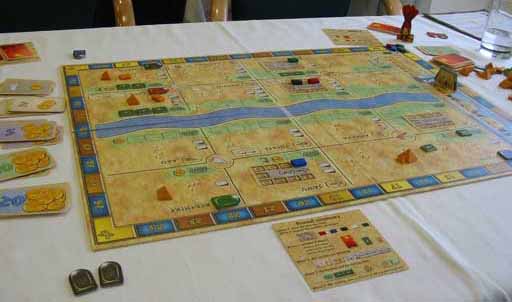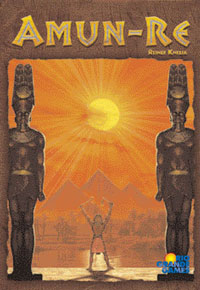This game is from the prolific Reiner Knizia and is published by Hans im Glück (in German) and Rio Grande Games (in English). As the name suggests, the game is themed to Ancient Egypt – though I’m more used to seeing the name of this Ancient Egyptian God rendered as Amon-Ra. The game is another of Knizia’s clever scoring systems and reminds me of Stephensons Rocket. Not for any thematic reason – the games are light years apart in theme – but because they both provide many ways of scoring points and the trick is to make the most of your opportunities. However, Amun-Re is the simpler of the two. The board (see picture below) shows the river Nile down the centre with the land on either side split into fifteen provinces. Each province is identified with a name and has a number of icons that show its properties. The playing pieces include plastic pyramids (in single and double denominations) and building blocks. There are cardboard chits to represent farmers. Money is in the form of cards in various denominations. There is a deck of action cards plus a set of cards for the provinces. The players each have a couple of plastic ‘chiclets’ – that really is the best way of describing them – in their colour, together with three cardboard markers to denote ownership of the provinces. Finally, there is a first player marker and another to show the current value of the farmers.  Amun-Re is played in two tranches of three turns apiece, with scoring at the end of each tranche. The player with the most points at the end wins the game – no surprises there. In each turn as many areas as there are players are put up for auction by dealing out province cards. Players start by making a bid for one area: they place their ‘chiclet’ on the amount they’re prepared to pay for the province. This will depend on what you value the province at – in later turns this will depend on how the particular province fits with your strategy. More than one player can bid on any area. When the turn comes round to them again, anyone who was over-bid must bid on a different province. This continues until everybody has an area they’re happy with (or can afford!). The money is paid out and players mark their ownership of the province on the board. Some provinces give bonuses to whoever buys them – an action card, a building block or even cash. This is one of the factors to consider when deciding how much to bid for a province. Now players can buy things: action cards, farmers and building blocks. The cost of each depends on how many you’re buying in the turn. One of anything costs 1; two costs 3, three 6 and so on. Farmers and building blocks are placed in provinces. However, farmers can only be placed in the spaces marked on the board. Some provinces can support lots of farmers, some none – another factor that affects the value of the province. For every three building blocks placed in the same province, a pyramid is constructed. And pyramids mean points! Once everybody’s done their thing, there is another interesting bidding action: the sacrifice to Amun-Re. Players secretly offer an amount of money to the God. The high bidders get extra things (building blocks, farmers or cards) free, which can be very useful. However, the total amount bid also determines how good the harvest is this year. This is reflected in the income received (1, 2, 3 or 4) for each farmer this turn. As one of the bids available to each player is ‘-3’ (for which they get cash back!), the bidding can get very strange. The player who made the highest bid also takes over as the start player. Now that we know how good the harvest is, players take their income. Some of the provinces have a camel icon with a money value. If the harvest is poor (1 or 2), the owners of these provinces get the additional income shown – representing extra food brought in by trade. Another factor to consider when deciding how much to bid for a province. And, as you can see, depending on which provinces (and cards) you hold, you may want income to be high or low – and need to make the appropriate sacrifice to Amun-Re. Once everybody’s got their cash, the next turn starts. Another set of provinces becomes available and players can add things to provinces they bought earlier. After three turns, players score points. Most points are scored for pyramids. You get one for each pyramid you own. You also get three points for each ‘set’ of three (a set being one pyramid in each of your three provinces). This encourages you to build pyramids evenly. The owner of the province with the most pyramids in it gets five points. This is scored for both sides of the Nile (and anyone who gets both in the first scoring round is well on the way to winning, in my experience). Clearly an incentive for putting all your pyramids in one place! Points are also scored by the owners of the provinces that contain temples. These are printed on the board, so all you have to do is buy the province. Yes, that’s another factor to consider when bidding. As the points scored (1-4 per temple) depend on the current harvest value, it’s also an incentive to make a large sacrifice to Amun-Re. And a disincentive to hold provinces with camel symbols. Finally, some of the action cards allow players to score points (always 3 for each card), depending on whether they only own provinces in one part of the board or have lots of farmers or card symbols in their provinces. Points scored are shown by moving your second ‘chiclet’ along the scoring track round the outside of the board. Then everything is cleared from the board, except the pyramids. The province cards used are shuffled together and re-used. Three more rounds are played and a second scoring takes place. This is the same as the first, except that there is also a bonus for the amount of money players hold: 6 points for the player with the most, 4 for the second and 2 for the third. The player with the most points after this wins the game.  What I’ve missed out of this so far are the action cards. Each of these allows players to do something special and they are colour coded to show when they can be played. Two can be played in the auction. One allows a player to make a second bid on the same province, the other forces others to bid two spaces higher if they want to over-bid the player. There are two for the buying/building phase. One allows you to build a pyramid for two building blocks (and everybody starts the game with one of these). The other gives a you a free farmer that goes outside the fields marked on the boards. Only one can be played during the sacrifice: it allows you to shift the total (which determines the income level) up or down by three points. This is very entertaining if several people play one in the same turn. Two cards influence income. One gives you an extra income for each farmer in a province: a reason to concentrate farmers. The other gives you a total income of 8 for a province – very useful if you have a province with no farmers! Finally, there are several points bonus cards as mentioned above. I should mention a few more points about the cards. You are limited in the number you can buy. Each province shows a number of cards. In one turn you can buy as many cards as the highest shown on your provinces (so, if your provinces show 0, 1 and 2, you can buy two cards at most). Guess what: here’s another factor for your valuation of provinces! Secondly, you can only play one of a particular card each turn. So, only one bonus farmer and one cheap pyramid. Thirdly, you can sell cards back to the bank for 1 gold at any time – very useful when you’ve got more cards than you can use. As far as I can see, cards are so useful that I tend to buy as many as I can afford – especially at the start of the game. I was surprised to discover that other people disagree and buy very few cards. (What I don’t know is whether these are the people who beat me, or the people who I beat.) As you can see from the lengthy explanation, this is a game with relatively complex mechanics – especially when you add in the interaction of the cards. The thing to bear in mind is that most points are scored by having pyramids. Farmers are the means to raise the money to buy more pyramids. Cards save you money or get you more money with which to buy pyramids. Some of them do give you points directly, but they also constrain which provinces you want to own (all on one side of the Nile, for example). So build pyramids! But remember that all the provinces are auctioned off again in the second half of the game. If you build lots of pyramids in the first half, you’ll have to bid high to get them back again in the second half. On the other hand, the increasing cost of buying several things in one turn means that you want to spread your purchases out. One building block in each turn will cost you 6 gold and get you two pyramids. Six blocks in one turn costs 21 gold. So Amun-Re is about maximising your opportunities to score points and denying them to others. Generally, this means looking for points no-one else is going for. Or winning the fights. I’ve enjoyed the game so far, despite only having won one game, and look forward to playing it a lot more.
Amun-Re was designed by Reiner Knizia and published (in German) by Hans im Glück and (in English) Rio Grande Games. It is a strategy board game for 3-5 players and takes about 90 minutes to play. It is readily available in specialist games shops in the UK at around £30.
Page created 2nd April 2004. Last modified 29th August 2021. This website produced by Paul Evans. © Copyright Paul Evans 2004-2021. All trademarks acknowledged. Problems, comments and feedback to the Webmaster. |
Pevans |